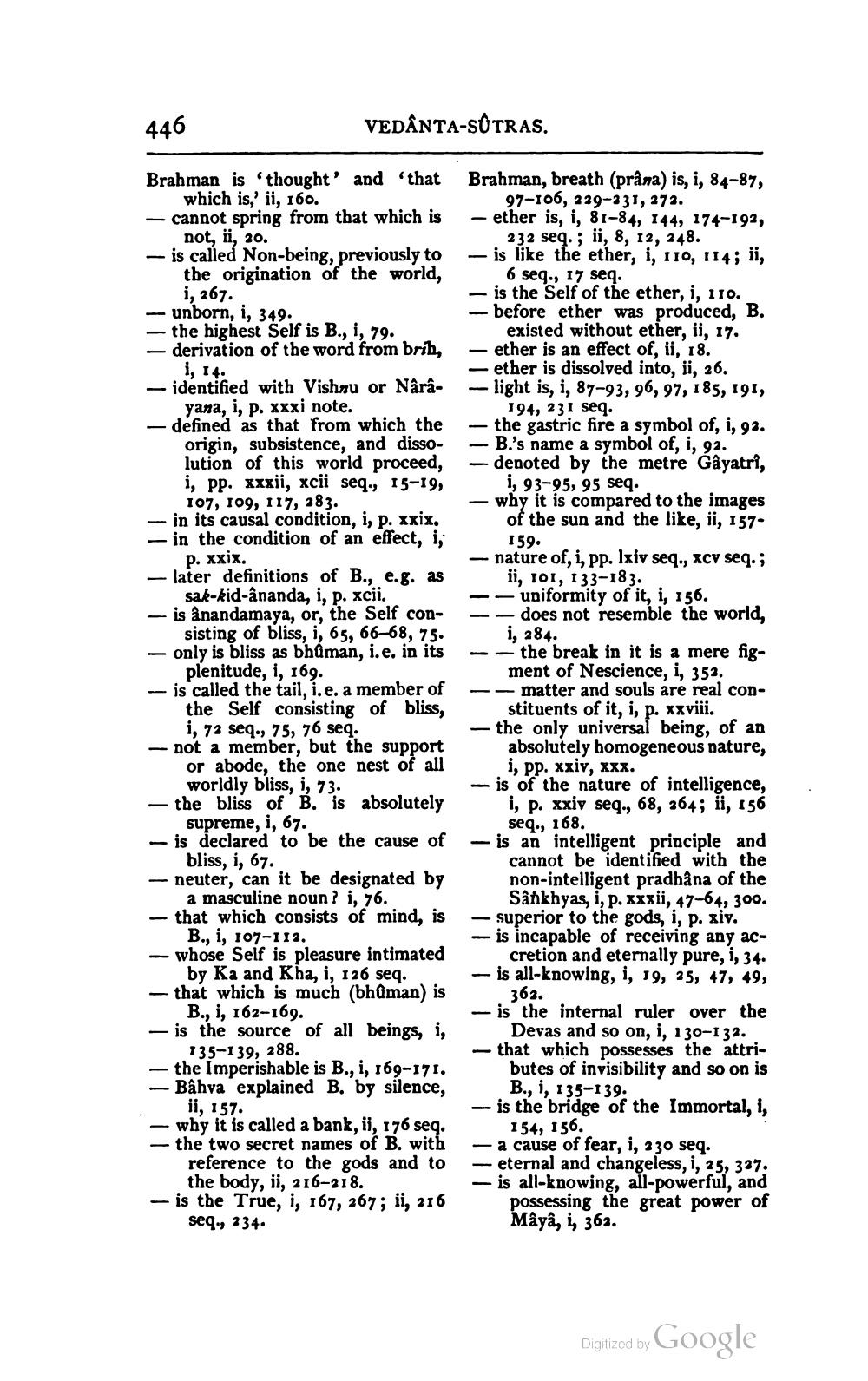________________
VEDANTA-SUTRAS.
446
Brahman is thought' and 'that which is,' ii, 160.
- cannot spring from that which is not, ii, 20.
- is called Non-being, previously to the origination of the world, i, 267.
- unborn, i, 349. -the highest Self is B., i, 79. - derivation of the word from brih, i, 14. -identified with Vishnu or Nârâyana, i, p. xxxi note. -defined as that from which the origin, subsistence, and dissolution of this world proceed, i, pp. xxxii, xcii seq., 15-19, 107, 109, 117, 283.
in its causal condition, i, p. xxix. - in the condition of an effect, i, p. xxix.
- later definitions of B., e.g. as sak-kid-ânanda, i, P. xcii.
- is ânandamaya, or, the Self consisting of bliss, i, 65, 66-68, 75. only is bliss as bhúman, i.e. in its plenitude, i, 169.
- is called the tail, i. e. a member of the Self consisting of bliss, i, 72 seq., 75, 76 seq.
- not a member, but the support or abode, the one nest of all worldly bliss, i, 73.
-the bliss of B. is absolutely supreme, i, 67.
- is declared to be the cause of bliss, i, 67.
-neuter, can it be designated by a masculine noun? i, 76.
- that which consists of mind, is B., i, 107-112.
whose Self is pleasure intimated by Ka and Kha, i, 126 seq. - that which is much (bhuman) is B., i, 162-169.
- is the source of all beings, i, 135-139, 288.
the Imperishable is B., i, 169-171. - Bâhva explained B. by silence, ii, 157.
- why it is called a bank, ii, 176 seq. -the two secret names of B. with reference to the gods and to the body, ii, 216-218.
- is the True, i, 167, 267; ii, 216 seq., 234.
Brahman, breath (prâna) is, i, 84-87, 97-106, 229-231, 272.
ether is, i, 81-84, 144, 174-192, 232 seq.; ii, 8, 12, 248.
- is like the ether, i, 110, 114; ii, 6 seq., 17 seq.
- is the Self of the ether, i, 110. - before ether was produced, B. existed without ether, ii, 17. -ether is an effect of, ii, 18.
ether is dissolved into, ii, 26. light is, i, 87-93, 96, 97, 185, 191, 194, 231 seq.
the gastric fire a symbol of, i, 92. -B.'s name a symbol of, i, 92. - denoted by the metre Gâyatri, i, 93-95, 95 seq.
why it is compared to the images of the sun and the like, ii, 157159.
- nature of, i, pp. lxiv seq., xcv seq.; ii, 101, 133-183.
1
-
uniformity of it, i, 156.
does not resemble the world, i, 284.
the break in it is a mere figment of Nescience, i, 352. -matter and souls are real constituents of it, i, p. xxviii. - the only universal being, of an absolutely homogeneous nature, i, pp. xxiv, xxx. -is of the nature of intelligence, i, p. xxiv seq., 68, 264; ii, 156 seq., 168.
- is an intelligent principle and cannot be identified with the non-intelligent pradhâna of the Sankhyas, i, p. xxxii, 47-64, 300. superior to the gods, i, p. xiv. - is incapable of receiving any accretion and eternally pure, i, 34. - is all-knowing, i, 19, 25, 47, 49,
362.
- is the internal ruler over the Devas and so on, i, 130-132. that which possesses the attributes of invisibility and so on is B., i, 135-139.
- is the bridge of the Immortal, i, 154, 156.
- a cause of fear, i, 230 seq.
eternal and changeless, i, 25, 327. is all-knowing, all-powerful, and possessing the great power of Mâyâ, i, 362.
-
Digitized by Google




